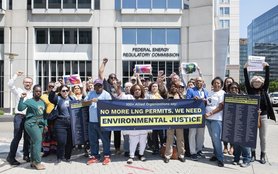Ban Ki-moon Climate Summit at risk of failing to help stop climate change from making people hungry
The cost of weather-related disasters in the five years since global leaders last met to discuss climate change is almost half a trillion dollars ($490 billion) – three times more than for the whole of the 1970s, Oxfam warns today, ahead of the UN Climate Summit on September 23rd.
In a new paper released today, The Summit that Snoozed? Oxfam estimates that more than 650 million people have been affected and more than 112,000 lives lost as a result of weather-related disasters since 2009. Since then, each year has been among the top ten most expensive on record. Poor people are being hit first and hardest by climate change. Many livelihoods and crops have been destroyed, increasing food prices and leaving millions hungry. At the same time, however, international commitments to reverse the threat of climate change have stalled.
“World leaders seem content to hit the snooze button one more time, but the alarm bells are ringing and people’s lives are at stake,” said Raymond C. Offenheiser, President of Oxfam America. “Climate change is happening in front of our eyes. The costs are only growing and delay will mean more people hungry, more devastating disasters and more lives lost.”
The Ban Ki-moon Climate Summit, taking place in New York city on Tuesday September 23rd is intended to galvanise global action to tackle climate change. But despite the UN Secretary General’s initiative, world leaders are expected to bring little to the table, and Oxfam cautioned that private sector initiatives lack the necessary ambition and scope to deliver a game-changing blow against climate change and offer no substitute for government action.
When leaders met in Copenhagen in 2009, they agreed to cut emissions but not by enough to avoid global warming of more than 2 degrees Celsius. However countries have done nothing to increase ambition since, despite plummeting costs of renewable energy. Some countries like Canada and Japan have backed away from their pledges altogether. The world is on course to warm by almost 4 degrees Celsius by the end of the century, which will guarantee wide-spread climate destruction and hunger.
Leaders also agreed to provide $30 billion of assistance to developing countries between 2010 and 2012, and then increasing it so developing countries had $100 billion a year by 2020 to protect themselves from climate change. This has been a failure too. Very few countries have committed to provide the increase in funds they should have in the next few years. Oxfam estimates that, at best, a total of between $16 and $17 billion is flowing per year, but the figure is closer to $8 or 9 billion when creative accounting is taken into account. The Green Climate Fund, set up to channel these funds has so far, only had $1.1 billion pledged of the $15 billion that is needed to get it up and running.
The political vacuum at the Summit is likely to be filled by announcements from the private sector. Oxfam believes that even potentially ground-breaking initiatives have shortcomings, including the “Africa Clean Energy Corridor”, which aims to connect half the continent to a greener grid but lacks concrete financial and company backing.
“Voluntary action by the private sector will not be enough on its own,” said Offenheiser. “We need strong political leadership and ambitious government policy to mobilize the global action that both the science and a growing number of people around the world demand. President Obama’s Climate Action Plan is an ambitious start to move the US in the right direction. But the administration cannot rest on its laurels and ultimately, Congress must end its intransigence or their constituents will bear the costs of inaction.”
Oxfam is calling for leaders at the Ban Ki-moon Climate Summit to re-commit to their 2 degrees Celsius goal, increase their near-term emissions reduction targets and agree new targets to phase out fossil fuel emissions entirely by the second half of the century. They must increase their climate finance to meet their target of $100 billion a year by 2020, and provide grants to the Green Climate Fund over the next three years totalling $15 billion. By Spring 2015, they must submit ambitious initial pledges for the UN Climate Conference in Paris at the end of next year, in line with their fair share of the global effort needed to put the world back on track to avoiding runaway climate change.
The private sector can help by pressing governments for better regulation, such as energy efficiency standards, more investment in renewables, cuts in fossil fuel subsidies and more climate finance. They must also cut their own emissions in line with the science and set targets to phase out fossil fuel emissions from their operations.
“Millions of people and thousands of companies and investors have already shown their willingness to be part of the solution,” said Offenheiser. “World leaders must reject the special interests that would put our world at risk to protect the status quo. Technological advances offer real opportunity to shape a new, safer world. But real leadership is urgently needed to seize the moment.”
//Ends
Notes to Editors:
According to the EM-DAT database, the total damage costs for 2010, 2011, 2012, 2013 and part of 2014 amount to $491, 827, 336,000 in 2013 constant prices. The whole of the 1970s cost approximately $160 billion in 2013 constant prices. The data is sourced from the Centre for Research on the Epidemiology of Disasters (CRED) at Louvain University (http://www.emdat.be), classifying the following disasters as climate-related: droughts, extreme temperatures, wildfires, storms, floods, mass movements (wet). All total costs were converted from current to constant 2013 prices using data from http://oregonstate.edu/cla/polisci/download-conversion-factors. Costs have increased since the 1970s due to more extreme weather, improvements in the reporting of weather disasters and increases in the number of people and the value of assets exposed to extreme weather.
A copy of the report “The Summit that Snoozed” will be available at http://oxf.am/zna


